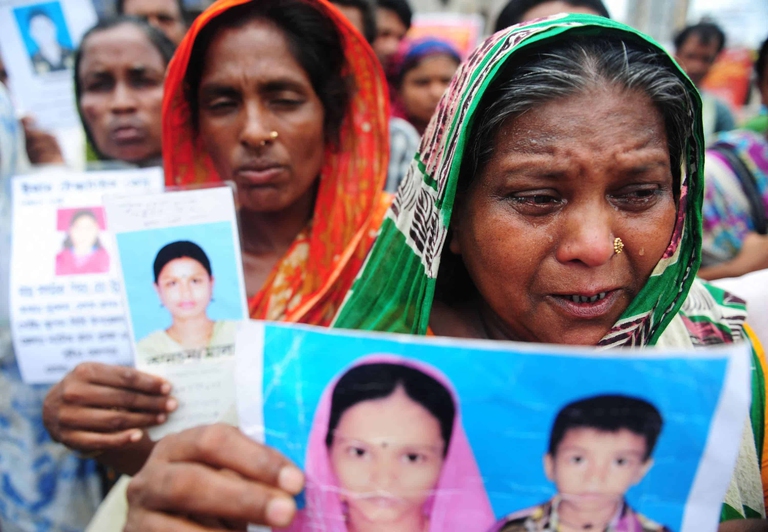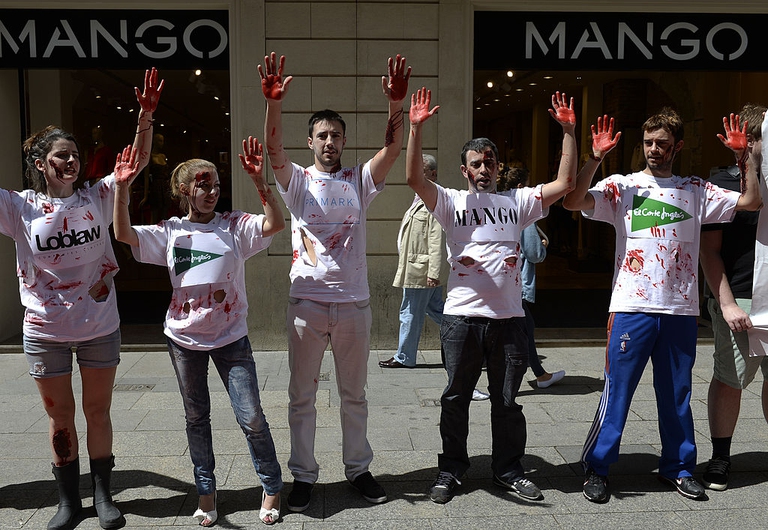https://www.lifegate.it/rana-plaza-dieci-anni
- |
- 1,138 dead and over 2,600 injured and disabled for life:this was the outcome of the biggest disaster in the fashion industry, the collapse of Rana Plaza.
- Western brands were slow to take responsibility for the tragedy, but international pressure led to two agreements that are still considered the greatest legacy of that episode:the agreement on the safety and prevention of fires in Bangladeshi factories and the Rana Plaza arrangement for compensation to survivors and victims' families.
- Despite the results achieved, there remain many open questions for workers in the fashion industry and have been exacerbated by the pandemic and the advent of so-called ultra fast fashion.
The dead never arrive without warning.That time, then, there were so many that they could no longer be ignored.The 1,138 victims of collapse of Rana Plaza, which occurred 10 years ago in Bangladesh, on 24 April 2013, they were not unexpected.It was the classic tragedy announced.The timeline on the site illustrates this well Rana Plaza never again, which reconstructs previous incidents which also occurred in the Dhaka area, where the clothing manufacturing factories are concentrated.
He remembers it well Deborah Lucchetti, Italian coordinator of the campaign Clean clothes, who that day was in Amsterdam at the headquarters of Clean Clothes, the international network made up of 240 associations that promotes workers' rights in fashion.“For us, that news was not surprising because we had been working on similar cases for years,” Lucchetti recalls today, “what we did not expect was, in fact, the media coverage of that particularly serious tragedy, and also its duration of time.Knowing how to seize that window of attention was fundamental for the Clean Clothes Campaign and other activists to put pressure on the brands involved and thus achieve two great results:the agreement on the safety and prevention of fires in Bangladeshi factories and the Rana Plaza arrangement for compensation to survivors and victims' families. The collapse of Rana Plaza was a watershed, for what it generated in terms of awareness of the impacts of fashion and I would also say a turning point on a regulatory level“.The event also contributed to changing the way the public perceived the fashion industry and fast fashion in particular, so much so that it kicked off the international movement of Fashion Revolution, in Italy coordinated by Marina Spadafora.
Dhaka, Bangladesh:the events of 23 and 24 April 2013
The day before the collapse, April 23, some workers in the complex on the outskirts of Dhaka, which housed five clothing factories on the upper floors and shops on the lower ones, noticed structural cracks in the building.While some shops decided to close, female factory workers were ordered to return to work the next day.No union, no rights and a lot of fear of losing their jobs and wages forced those people to return to Rana Plaza a few hours before the collapse. Entire families were wiped out, some bodies were never found, others were named only after DNA analysis.It took weeks to clarify the number of victims:“They tried to move the concrete slabs above us by hand.People pulled me from both sides until they managed to get me out.The weight of the cement had compromised my uterus, which they had to completely remove that same evening,” said Shila Begum, a 26-year-old survivor.


The search for labels and the fight for compensation
Like Shila, at least 2,600 other people were injured, many disabled for life.Like her, the other injured and the families of the victims demanded justice.“Of the two agreements, the one for compensation for the victims was certainly the longest and most difficult process,” explains Lucchetti, “no brand wanted to put money into it, because it would have been an unequivocal admission of responsibility.And in the end, in order to reach an agreement, the brands were allowed to pay the money into a fund, the Trust Fund, even anonymously.Some did just that." In the days following the collapse, in fact, no fashion brand came forward admitting to sourcing from those factories.It was journalists, activists and local people who dug under the rubble and found clothing labels or sheets of orders that explicitly mentioned the names of those involved, among these the Italian Benetton, among the most reluctant to admit their responsibilities, Auchan, Gap, H&M, Mango, Primark.

“The compensation agreement managed to raise around 30 million dollars,” continues Lucchetti.“It is a historic agreement, later used as a model for other situations.The compensation scheme was coordinated by the International Labor Organization, and provided compensation for lost wages, due to the disability or loss of a worker's family member, and for medical care.It did not, however, include psychological damage.The compensation was calculated based on the poverty wages of those workers, so those 30 million are not as much as they seem.And an incessant two-year campaign was necessary to seal the deal.The most important legacy certainly remains the fact that for the first time compensation was recognized on the basis of the convention on accidents at work, effectively establishing that the client is responsible for what happens in his supply chain and therefore must take charge of the fate of the workers, even if they are not direct".
Rana Plaza, the important legacy of the security agreement
In the same way, the safety agreement was also a fundamental step that allows workers in Dhaka to be safer today than ten years ago, continues Lucchetti:“The foundations were laid for that a couple of months after the collapse and many brands signed it, more than 200.It has already been renovated twice and substantially is based on qualified and independent inspections, who identify problems and develop corrective plans.Everything is public. Workers have the opportunity to make reports anonymously and receive adequate safety training.On the one hand, client companies have the obligation to financially guarantee the requalification of their suppliers, on the other, factories that do not comply, after a certain number of recalls, are expelled from the possibility of supplying the signatory brands.And that's obviously a big deterrent.Over the course of 10 years, this agreement has secured 1,600 factories for approximately 2.5 million workers:for this reason today it is essential to defend and expand it, as has just happened in Pakistan".
A European campaign for a decent wage
The common link of both these agreements, which has allowed them to work, are the obligations that bind the signatories.As he explains Priscilla Robledo, lobby & advocacy coordinator of Abiti Puliti:“Over the years we have understood that everything done voluntarily by brands is not effective. The market is not capable of self-regulation effectively on issues relating to safety, transparency, workers' rights, decent wages.We need rules.This is also why the campaign we are carrying out on a decent wage Good clothes, fair pay has the final objective of arriving at a European legislative proposal on this topic, which will integrate the proposal for a directive on due diligence which is being discussed in Brussels.
Anyone who works has the right to a wage that allows them to live with dignity and to give an equally dignified life to one's family" (you can contribute to the campaign sign online).In terms of transparency, then, the collapse of Rana Plaza gave rise to another major pressure campaign, that for the Transparency Pledge, to ensure that i fashion brands share their supplier list.Robledo continues:“It was something unthinkable once:for companies it was a trade secret.Today, those who sign up to the Transparency Pledge publish online their name, address, number of workers and type of products they buy from a particular factory.It is crucial information that is used by activists, unions and workers, who often, like at Rana Plaza, don't even know who they are producing those garments or accessories for."
Despite the results achieved, the open questions for workers in the fashion industry (estimated at more than 75 million, of which 85 percent are women) remain many and have been exacerbated by the pandemic and theadvent of the so-called ultra fast fashion, as Lucchetti comments:“This model, even faster than fast fashion, has amplified the problems.Suppliers are being overwhelmed by demands for ever faster production and at ever lower costs."The Asian area remains of great importance for the Clean Clothes campaign which operates in close collaboration with trade unions and local entities, which contribute to international working groups, "but for us Europeans, and Italians in particular, attention must be paid to also to the Eastern European bloc.Croatia, Serbia, Romania, Bulgaria, Turkey are countries where we observe the same serious problems", concludes Lucchetti, "the fashion industry must change radically:obligations and responsibilities must be imposed by law or through negotiation on companies and must apply to the entire supply chain".
It is necessary to continue working on all of this, aiming for a change in the fashion system and also in the ways in which fashion is consumed by the public.Ten years after Rana Plaza, the pressure for a more ethical and safe supply chain for workers all over the world cannot stop.
